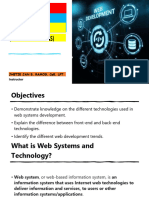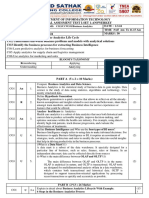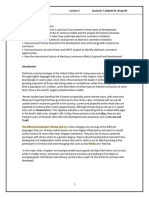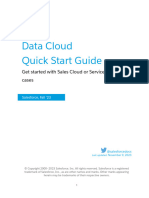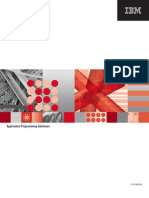0 ratings0% found this document useful (0 votes)
32 viewsWeb Design and Programming CH-5
Server side scripting allows scripts to execute on a web server to dynamically generate responses for users. PHP is a popular server side scripting language that can be used to create dynamic content, interactive pages, integrate databases, and send emails. It has advantages of being free, widely used, and versatile but also has disadvantages related to security and performance.
Uploaded by
metasebiamerkin7275Copyright
© © All Rights Reserved
Available Formats
Download as PPTX, PDF, TXT or read online on Scribd
0 ratings0% found this document useful (0 votes)
32 viewsWeb Design and Programming CH-5
Server side scripting allows scripts to execute on a web server to dynamically generate responses for users. PHP is a popular server side scripting language that can be used to create dynamic content, interactive pages, integrate databases, and send emails. It has advantages of being free, widely used, and versatile but also has disadvantages related to security and performance.
Uploaded by
metasebiamerkin7275Copyright
© © All Rights Reserved
Available Formats
Download as PPTX, PDF, TXT or read online on Scribd
You are on page 1/ 14
CHAPTER 5
SERVER SIDE SCRIPTING
Server Side Scripting
• Server side scripting is a technique in web development that involves executing
scripts on a web server that produce a customized response for each user's
request.
• Server-side scripting is a programming technique that enables web developers to
create dynamic and interactive web pages.
• Server-side scripts are executed on the web server, which is a computer that hosts
the website.
• When a user visits a website that uses server-side scripting, the web server first
retrieves the requested page from the website's file system. The web server then
executes the server-side scripts on the page, which can be used to dynamically
generate content, process user input, and interact with databases. The web server
then sends the generated page back to the user's web browser.
Server Side Scripting
• There are many different server-side scripting languages, including PHP, ASP.NET,
Python, and Ruby. Each language has its own strengths and weaknesses, so the
best language for a particular project will depend on the specific requirements of
the project.
• Here are some of the advantages of using servDynamic content: Server-side scripting can
be used to dynamically generate content, such as news articles, product listings, and user
profiles. This allows websites to provide users with up-to-date information and
personalized experiences.
• User interaction: Server-side scripting can be used to create interactive web pages, such as
forms, games, and chat applications. This allows users to interact with the website in a
more meaningful way.
• Database integration: Server-side scripting can be used to integrate websites with
databases. This allows websites to store and retrieve data, such as customer records,
product inventory, and order history.
Server Side Scripting
• Here are some of the disadvantages of using server-side scripting:
• Security: Server-side scripts can be vulnerable to security attacks, such as
cross-site scripting (XSS) and SQL injection. This can allow attackers to steal
user data or take control of a website.
• Performance: Server-side scripts can slow down the performance of a
website. This is because the web server has to execute the scripts on every
request.
• Complexity: Server-side scripting can be complex to learn and use. This is
because it requires knowledge of both web development and programming
languages.
PHP
• PHP is a general-purpose scripting language that is especially suited
for web development.
• It is a free and open-source language that is used by millions of
developers around the world. PHP is a server-side language, which
means that it is executed on the web server and not on the user's
computer. This makes PHP ideal for creating dynamic and interactive
web pages.
PHP
• PHP is a powerful language that can be used to do a variety of tasks,
including:
• Generating dynamic content: PHP can be used to dynamically generate
content, such as news articles, product listings, and user profiles. This allows
websites to provide users with up-to-date information and personalized
experiences.
• Creating interactive web pages: PHP can be used to create interactive web
pages, such as forms, games, and chat applications. This allows users to
interact with the website in a more meaningful way.
• Integrating with databases: PHP can be used to integrate websites with
databases. This allows websites to store and retrieve data, such as customer
records, product inventory, and order history.
PHP
• Sending email: PHP can be used to send email from websites. This can be
used to send notifications, confirmations, and marketing messages to users.
• Creating web applications: PHP can be used to create web applications, such
as content management systems (CMS), e-commerce platforms, and social
networking sites.
• PHP is a versatile and powerful language that can be used to create a
wide variety of web applications. It is a popular choice for both
beginners and experienced developers.
PHP
• Here are some of the advantages of using PHP:
• Free and open-source: PHP is a free and open-source language, which means
that it is available to everyone. This makes it a great option for budget-
minded developers.
• Widely used: PHP is a widely used language, which means that there is a large
community of developers who are familiar with it. This makes it easy to find
help and support when you need it.
• Versatile: PHP is a versatile language that can be used for a variety of tasks.
This makes it a good choice for developers who need a language that can do a
lot of different things.
• Easy to learn: PHP is a relatively easy language to learn. This makes it a good
choice for beginners who want to get started with web development.
PHP
• Here are some of the disadvantages of using PHP:
• Security: PHP can be vulnerable to security attacks, such as cross-site scripting
(XSS) and SQL injection. This can allow attackers to steal user data or take
control of a website.
• Performance: PHP can be slow compared to some other languages, such as
Python or Ruby. This is because PHP is a compiled language, which means
that it has to be converted into machine code before it can be executed.
• Complexity: PHP can be complex to learn and use. This is because it is a large
language with a lot of features.
PHP Syntax
• Setup
• Syntax
• Variables
• Echo and print
• String methods
• Strlen()
• Str_word_count()
• Strrev()
• Strpos()
• Str_replace()
PHP Syntax
• Math
• Pi()
• Min() and max()
• Abs()
• Sqrt()
• Round()
• Rand()
• Constant
• Define()
PHP Syntax
• Conditions
• Loops
• While
• Do-while
• For
• foreach
• Functions
• Arrays
• Sort()
PHP Syntax
• Form Handling
• Get
• Post
• Routing with parameters
Example Programs in PHP
• Hashing methods
• Iterating through arrays
• Getting all users
• Getting a single user
• Deleting a single user
• Updating user information
You might also like
- Web Design, Programmig and AdministrationNo ratings yetWeb Design, Programmig and Administration45 pages
- Web Desing, Programmig and AdministrationNo ratings yetWeb Desing, Programmig and Administration83 pages
- Online Faculty & Staff Directory For CollegeNo ratings yetOnline Faculty & Staff Directory For College8 pages
- Introduction To PHP: Julie Scott OIT, Faculty Support Program Lead, Learning TechnologyNo ratings yetIntroduction To PHP: Julie Scott OIT, Faculty Support Program Lead, Learning Technology5 pages
- CSCP 369 Web Applications: Christian Service University College, KumasiNo ratings yetCSCP 369 Web Applications: Christian Service University College, Kumasi20 pages
- PHP Introduction: Darshan Institute of Engineering & TechnologyNo ratings yetPHP Introduction: Darshan Institute of Engineering & Technology3 pages
- PHP Crash Course For Beginners: Hassan JabbarNo ratings yetPHP Crash Course For Beginners: Hassan Jabbar9 pages
- Learn PHP Programming in 7Days: Ultimate PHP Crash Course For BeginnersFrom EverandLearn PHP Programming in 7Days: Ultimate PHP Crash Course For Beginners3/5 (11)
- PowerShell Practitioner: Understanding The Core Building Blocks of Programming & Scripting through PowerShell, Plus Debunking Popular MisconceptionsFrom EverandPowerShell Practitioner: Understanding The Core Building Blocks of Programming & Scripting through PowerShell, Plus Debunking Popular MisconceptionsNo ratings yet
- Methods and Techniques of Data ProcessingNo ratings yetMethods and Techniques of Data Processing22 pages
- CCW331 BA IAT 1 Set 1 & Set 2 QuestionsNo ratings yetCCW331 BA IAT 1 Set 1 & Set 2 Questions19 pages
- 1 Howard Buys A Tablet Computer.: Turn OverNo ratings yet1 Howard Buys A Tablet Computer.: Turn Over4 pages
- BA 707 Summer 2020 in Class Assignment Current State0% (1)BA 707 Summer 2020 in Class Assignment Current State8 pages
- Questions Related To SAP Print ManagementNo ratings yetQuestions Related To SAP Print Management2 pages
- Decision Support and Business Intelligence SystemsNo ratings yetDecision Support and Business Intelligence Systems57 pages
- AWS+Partner+ +SAP+on+AWS+ (Technical) +v2.1.0+Student+GuideNo ratings yetAWS+Partner+ +SAP+on+AWS+ (Technical) +v2.1.0+Student+Guide289 pages
- PHP for Beginners: Your Guide to Easily Learn PHP In 7 DaysFrom EverandPHP for Beginners: Your Guide to Easily Learn PHP In 7 Days
- Introduction To PHP: Julie Scott OIT, Faculty Support Program Lead, Learning TechnologyIntroduction To PHP: Julie Scott OIT, Faculty Support Program Lead, Learning Technology
- CSCP 369 Web Applications: Christian Service University College, KumasiCSCP 369 Web Applications: Christian Service University College, Kumasi
- PHP Introduction: Darshan Institute of Engineering & TechnologyPHP Introduction: Darshan Institute of Engineering & Technology
- Learn PHP Programming in 7Days: Ultimate PHP Crash Course For BeginnersFrom EverandLearn PHP Programming in 7Days: Ultimate PHP Crash Course For Beginners
- PowerShell Practitioner: Understanding The Core Building Blocks of Programming & Scripting through PowerShell, Plus Debunking Popular MisconceptionsFrom EverandPowerShell Practitioner: Understanding The Core Building Blocks of Programming & Scripting through PowerShell, Plus Debunking Popular Misconceptions
- BA 707 Summer 2020 in Class Assignment Current StateBA 707 Summer 2020 in Class Assignment Current State
- Decision Support and Business Intelligence SystemsDecision Support and Business Intelligence Systems
- AWS+Partner+ +SAP+on+AWS+ (Technical) +v2.1.0+Student+GuideAWS+Partner+ +SAP+on+AWS+ (Technical) +v2.1.0+Student+Guide

















